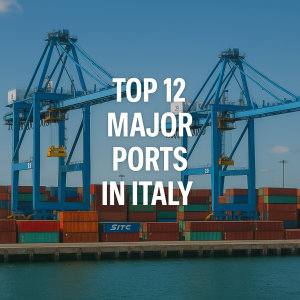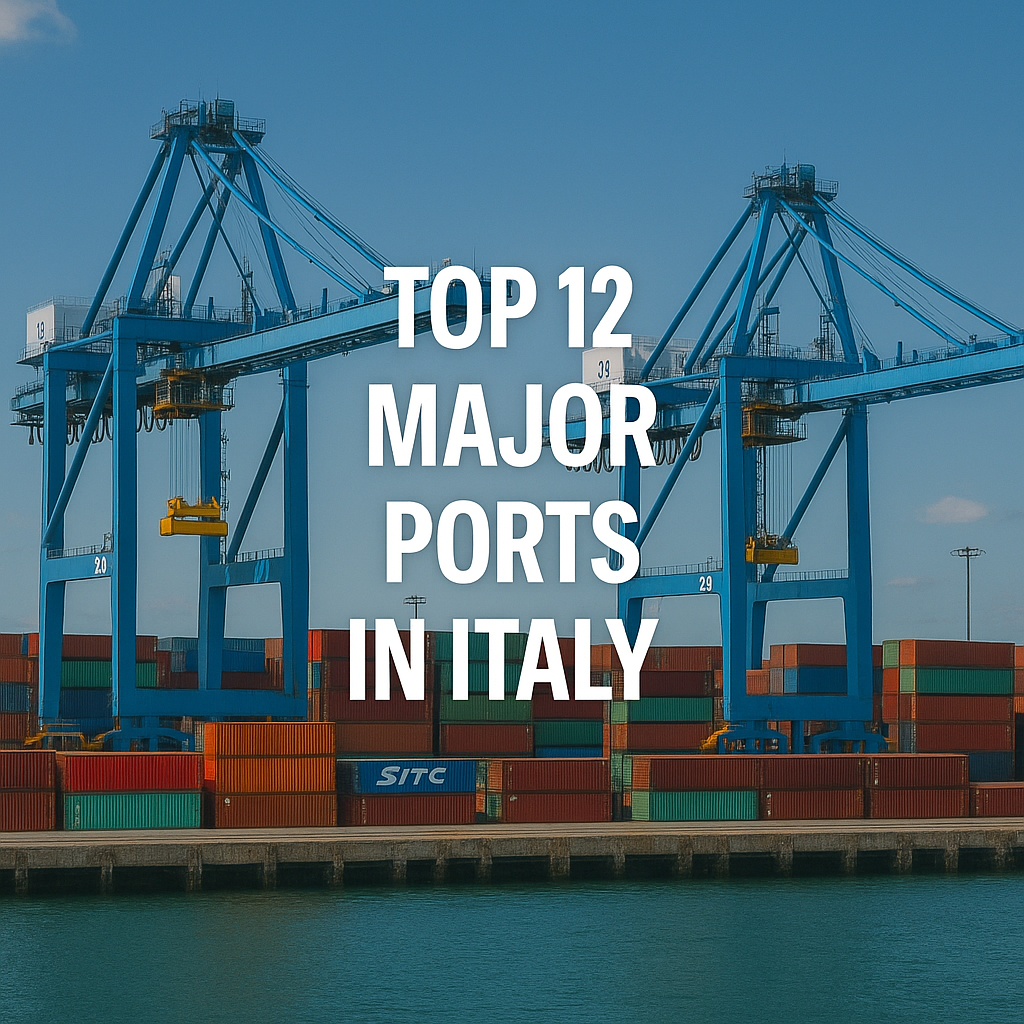Discover the top 12 major ports in Italy that power trade and maritime logistics. Explore their roles in container traffic, energy supply, and regional development in this comprehensive, data-driven guide.

Why Italian Ports Matter in Modern Maritime Operations
Italy, with its extensive coastline and strategic position at the heart of the Mediterranean, has long played a pivotal role in global maritime trade. As a member of the European Union and a key access point for cargo flowing between Asia, Africa, and Europe, Italy’s ports are central to both regional supply chains and global logistics networks.
According to ESPO and UNCTAD, Italian seaports handle more than 480 million tonnes of cargo annually, including containers, bulk goods, and energy products. These ports serve as vital hubs for automotive exports, cruise tourism, and intermodal logistics, connecting maritime routes with Europe’s vast inland transportation networks.
1. Port of Genoa (Liguria)
- 2023 Throughput: Over 67 million tonnes
- Specialties: Containers, petroleum products, ferries, ro-ro traffic
- Strategic Importance: Italy’s largest port by volume; part of the Ligurian Sea Port System Authority
- Investments: €2.3 billion infrastructure upgrades, smart port integration
Website: https://www.portsofgenoa.com
2. Port of Trieste (Friuli Venezia Giulia)
- 2023 Throughput: Approx. 62 million tonnes
- Strengths: Largest Italian oil port; gateway to Austria, Germany, and Central Europe
- Connectivity: Strong rail corridor access, port of entry for China’s Belt and Road Initiative
- Unique Feature: Special Free Port status (customs-free zones)
Website: https://www.porto.trieste.it
3. Port of Livorno (Tuscany)
- 2023 Throughput: Approx. 34 million tonnes
- Focus Areas: Ro-ro, cruise ships, breakbulk, and containers
- Innovations: Darsena Europa (new mega-terminal), green port planning
- Heritage: Historic port built by the Medici family
Website: https://www.portialtotirreno.it
4. Port of Gioia Tauro (Calabria)
- 2023 Throughput: Over 3.2 million TEUs
- Role: Largest container transshipment hub in Italy
- Capacity: Ultra-large container ships; part of the MSC global network
- Challenges: Security concerns, automation lag, labor strikes
Website: https://www.portogioiatauro.it
5. Port of Naples (Campania)
- 2023 Throughput: Approx. 25 million tonnes
- Versatility: Ferries, cruise ships, containers, bulk cargo
- Tourism: One of the busiest cruise ports in the Mediterranean
- Modernization: Digitization programs and port authority consolidation with Salerno and Castellammare di Stabia
Website: https://www.porto.napoli.it
6. Port of Ravenna (Emilia-Romagna)
- 2023 Throughput: Approx. 27 million tonnes
- Specialization: Dry bulk, general cargo, cereals, chemicals
- Port Development Plan: €250 million for channel deepening and terminal upgrades
- Inland Reach: Access to northern and eastern Italian industrial clusters
Website: https://www.port.ravenna.it
7. Port of Civitavecchia (Lazio)
- 2023 Throughput: 11 million tonnes
- Functions: Rome’s main seaport; cruise terminal, auto exports, energy imports
- Cruise Hub: Handles over 2.5 million cruise passengers annually
- Green Goals: LNG bunkering and electrification of berths
Website: https://www.portidiroma.it
8. Port of Palermo (Sicily)
- 2023 Throughput: Approx. 8 million tonnes
- Focus: Cruise, ro-ro, ship repair, regional ferry services
- Notable Facilities: Fincantieri shipyard, intermodal freight terminal
- Tourism Gateway: Vital to Sicily’s passenger economy
Website: https://www.adsppalermo.it
9. Port of Venice (Veneto)
- 2023 Throughput: Approx. 24 million tonnes
- Identity: Multi-purpose port with strong petrochemical and general cargo sectors
- Environmental Focus: Projects to reduce dredging and emissions, offshore terminals for cruise ships
- Risks: Flooding and sedimentation issues
Website: https://www.port.venice.it
10. Port of Bari (Apulia)
- 2023 Throughput: 9 million tonnes
- Key Services: Ferries to Albania, Greece, and Croatia; cruise terminal
- Strategic Role: East Adriatic trade and humanitarian corridor to the Balkans
- Infrastructure: Multi-purpose terminal upgrades and new logistics zones
Website: https://www.adspmam.gov.it
11. Port of Taranto (Apulia)
- 2023 Throughput: Approx. 10 million tonnes
- Specialties: Bulk cargo, steel products, containers
- Rebirth Strategy: Public-private partnerships to attract new carriers and logistics firms
- Innovation: AI-based cargo flow management system pilot
Website: https://www.port.taranto.it
12. Port of Cagliari (Sardinia)
- 2023 Throughput: Over 7 million tonnes
- Facilities: Container terminal, oil refinery logistics, ferry terminals
- Challenges: Inter-island connectivity and competition from mainland ports
- Potential: Critical node for Mediterranean short-sea shipping
Website: https://www.porto.cagliari.it
Real-World Applications: Italy’s Ports in Strategic Context
Trieste: A New Silk Road Gateway
The Port of Trieste has emerged as a crucial maritime and rail gateway for Central and Eastern Europe. Its Special Free Port regime enables customs-exempt trade, attracting German, Austrian, and Chinese logistics firms.
Gioia Tauro: The Transshipment Turnaround
Despite historic labor and governance challenges, Gioia Tauro’s alignment with MSC’s global logistics network has revitalized its transshipment traffic. Its position midway along East-West sea routes gives it an edge in container relay operations.
Venice: Balancing Commerce and Climate
Venice is exploring offshore port projects to protect its fragile lagoon while maintaining commercial viability. Its story highlights the delicate balance between preserving heritage and advancing maritime commerce.
FAQs
1. Which is the busiest cargo port in Italy? Genoa leads in overall tonnage, while Gioia Tauro handles the most containerized cargo.
2. How do Italian ports connect to inland logistics? Most major ports are integrated with national rail and highway networks, facilitating intermodal transfers to cities like Milan, Turin, and Bologna.
3. Are Italian ports involved in cruise tourism? Yes. Civitavecchia, Naples, Venice, and Palermo are among the busiest cruise hubs in Europe.
4. What environmental measures are Italian ports taking? Initiatives include LNG bunkering, shore power facilities, smart energy management, and dredging reduction programs.
5. Are Italian ports part of the Belt and Road Initiative? Ports like Trieste and Genoa are increasingly linked to China’s BRI via rail and sea investments.
6. How are Italy’s ports recovering from pandemic disruptions? Many ports have rebounded due to increased container traffic, digitalization, and EU Recovery Fund investments.
7. What industries rely most on Italian ports? Automotive, petrochemical, steel, food and beverage, tourism, and energy sectors all heavily rely on maritime logistics.
Conclusion
Italy’s top 12 ports are not just gateways for cargo—they are dynamic economic engines, cultural landmarks, and innovation centers. From Trieste’s logistics corridor to Gioia Tauro’s container prowess, these ports serve as critical links in both regional and global maritime networks.
As Italy pursues sustainability, digitization, and infrastructure resilience, its ports are poised to remain competitive, versatile, and strategically vital in the evolving maritime landscape.
Call to Action: For maritime students, port planners, and industry professionals, staying informed about Italy’s port strategies is essential. Monitor port authority websites, ESPO reports, and EU infrastructure programs to understand where the future of shipping is headed.
References
- European Sea Ports Organisation (ESPO). (2023). Port Performance Reports. https://www.espo.be
- Italian Port Authority Websites (as listed)
- UNCTAD. (2023). Review of Maritime Transport. https://unctad.org
- Lloyd’s List Intelligence. (2023). Top Mediterranean Port Rankings. https://lloydslist.maritimeintelligence.informa.com
- IHS Markit / S&P Global. (2023). European Maritime Trade Flows
- Port of Genoa. (2023). Strategic Infrastructure Plan. https://www.portsofgenoa.com
- Maritime Traffic Data. (2023). https://www.marinetraffic.com


I aam genuinely delighted to glance aat this web site posts which consists of
plenty of valuable data, thanks for providing these data.